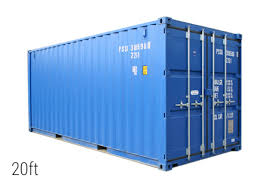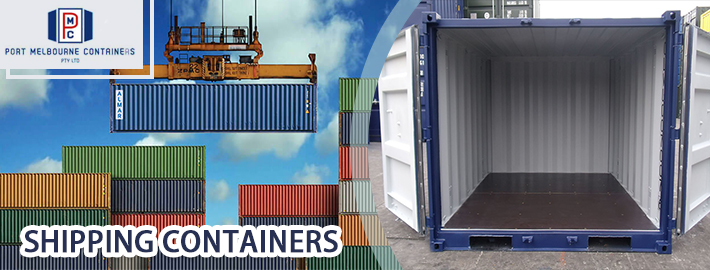Shipping containers have revolutionised the transportation industry, enabling efficient and secure movement of goods across the globe. But their impact extends far beyond freight alone. In recent years, shipping containers for sale have emerged as a game-changing solution in the world of warehousing, reshaping the future of this crucial sector.
In this article, we will explore how shipping containers are transforming traditional warehousing practices, offering advantages that were previously unimaginable. From optimising storage space to enhancing efficiency and workflow, these versatile metal giants hold immense potential for businesses looking to stay ahead in an increasingly competitive market

The Rise of Shipping Containers in Warehousing
The introduction of shipping containers into warehousing not only revolutionised the way goods are stored but also improved inventory management practices. The consistent size and shape of these containers simplify sorting and organising processes within warehouses, eliminating much of the guesswork associated with storing different-sized items. This streamlining not only saves time but also reduces errors in inventory tracking systems.
In addition to their practical benefits, the rise of shipping containers in warehousing has had a positive environmental impact. By repurposing these containers instead of manufacturing new structures from scratch, carbon emissions associated with production are significantly reduced. Furthermore, this up cycling approach aligns with sustainability goals by giving new life to materials that would otherwise go to waste.
With every passing year, shipping containers continue to reshape the future of warehousing by offering an innovative solution that optimises space utilisation and enhances operational efficiency
Advantages of Using Shipping Containers in Warehousing
The utilisation of shipping containers in warehousing provides a myriad of advantages that revolutionise the logistics industry. First and foremost, these containers are incredibly versatile, with their standardised dimensions allowing for easy stacking, transportation, and handling across various modes of transportation. This promotes seamless integration within supply chains, ensuring swift movement from port to warehouse and beyond.
Moreover, shipping containers for sale offer unparalleled durability and security. Constructed from sturdy materials such as corten steel, they can withstand harsh weather conditions and protect valuable goods from external elements. Additionally, their robust locking systems provide an added layer of protection against theft and unauthorised access.
Furthermore, the modularity of shipping containers allows for flexible space optimisation. With their ability to be stacked both vertically and horizontally, warehouses can efficiently utilise every inch of available storage capacity. This maximisation of space leads to cost savings by reducing the need for additional warehouse facilities.
Evolution of Warehousing Techniques with Shipping Containers
In the ever-evolving landscape of warehousing, shipping containers have emerged as a game-changer, revolutionising traditional storage methods. These sturdy metal giants are not just mere vessels for transporting goods across oceans; they have evolved into versatile structures that redefine the very concept of warehousing.
The advent of shipping containers has spurred innovation in how warehouses are designed and utilised. Gone are the days when rigid concrete walls dictated storage limitations. With the introduction of shipping containers, warehouses have embraced a more flexible approach, allowing for modular and scalable solutions.
By stacking and arranging these containers in various configurations, warehouse owners can maximise their storage capacity while maintaining efficient access to goods.
Furthermore, the integration of advanced technologies has propelled the evolution of warehousing techniques with shipping containers. Automated retrieval systems and robotic machinery can now seamlessly navigate through container stacks to retrieve specific items quickly and accurately.
This not only speeds up order fulfilment but also optimises inventory management, leading to enhanced productivity and customer satisfaction.
As we look towards the future, it is evident that shipping containers will continue to shape the dynamics of warehousing. Their adaptability opens doors for creative solutions such as repurposing old or unused containers into pop-up warehouses or temporary storage units during peak seasons. The potential for sustainable practices also emerges as these repurposed containers contribute to recycling efforts and reduce the need for constructing new warehouse facilities.
Optimising Storage Space with Shipping Containers
Within the realm of warehousing, one cannot underestimate the transformative power of shipping containers when it comes to maximising storage space. These uniform, sturdy metal giants have revolutionised the way businesses utilise their square footage and have become an indispensable tool for efficient storage management.
By harnessing the ability to stack and interlock these containers, warehouses can achieve unprecedented levels of vertical storage, instantly multiplying their capacity without expanding their physical footprint.
The beauty lies in the versatility of shipping containers; they are like building blocks for a warehouse architect’s dream. With their standardised dimensions, they seamlessly integrate into existing infrastructures, allowing for easy customisation and modification.
Their modular nature enables warehouses to create organised shelving systems within each container, utilising every nook and cranny efficiently. From adjustable racks to pull-out drawers and sliding compartments, the possibilities are endless.
Moreover, the adaptability of shipping containers extends beyond traditional storage methods. They can be effortlessly transformed into temperature-controlled units or specialised compartments for delicate merchandise or hazardous materials. This adaptability not only optimises space but also ensures that goods are stored in optimal conditions, retaining their quality throughout the supply chain.
Cost-Effectiveness of Shipping Containers in Warehousing
Shipping containers have revolutionised the warehousing industry, not only in terms of their versatility but also due to their exceptional cost-effectiveness. These standardised metal giants offer an affordable and sustainable solution for businesses seeking efficient storage options.
With their durable construction, shipping containers require minimal maintenance and can withstand harsh weather conditions, reducing long-term expenses.
Moreover, the modular nature of shipping containers allows for easy scalability. Businesses can adjust their storage capacity as per demand by simply adding or removing containers from their warehouse setup.
This flexibility eliminates the need for costly construction projects or lengthy lease agreements that traditional warehouses often entail. By embracing shipping containers, companies can optimise their storage space while keeping overhead costs to a minimum.
Enhancing Efficiency and Workflow with Shipping Containers
Shipping containers have revolutionised the world of warehousing by offering a versatile solution to enhance efficiency and workflow. These sturdy metal giants are not merely storage units but can be transformed into functional workspaces that streamline operations.
By repurposing shipping containers as mini-offices or break rooms within a warehouse, employees can conveniently access a designated space without wasting time moving to a separate building.
Conclusion
The future of warehousing is undeniably intertwined with the utilisation of shipping containers. These versatile and durable structures have revolutionised the way goods are stored, transported, and organised. As we gaze upon the horizon of innovation, it becomes clear that shipping containers for sale will continue to shape the landscape of warehousing. From their cost-effectiveness to their ability to optimise storage space, these containers are a beacon of hope for a more efficient and sustainable future.
So let us embrace this transformative trend with open arms, for within the steel walls of these containers lies a world of endless possibilities waiting to be explored.

